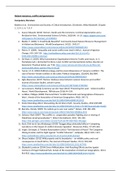Natural resources, conflict and governance
Compulsory literature
Robbins et al. Environment and Society; A Critical Introduction, Chichester, Wiley-Blackwell. Chapter
1, 2,3 4, 5, 6, 7, 8, 9
1. Araral, Eduardo (2013) ‘Ostrom, Hardin and the Commons: A Critical Appreciation and a
Revisionist View’, Environmental Science & Policy, 36(2014): 11-23. https://papers.ssrn.com/
sol3/papers.cfm?abstract_id=2338354
2. Blaikie, P. (2006) ‘Is Small Really Beautiful? Community-based Natural Resource Management
in Malawi and Botswana’, World Development, 34(11): 1942-57.
https://www.sciencedirect.com/science/article/pii/S0305750X06001343
3. Peters, P. (2004), ‘Inequality and social conflict over land in Africa’, Journal of Agrarian
Change, (4)3: 269-314. http://onlinelibrary.wiley.com/doi/10.1111/j.1471-
0366.2004.00080.x/abstract
4. De Waal, A. (2009), Why Humanitarian Organizations Need to Tackle Land Issues, in: S.
Pantuliano (ed.), Uncharted Territory: Land, Conflict and Humanitarian Action, Bourton on
Dunsmore: Practical Action, pp. 9-26; http://www.odi.org.uk/sites/odi.org.uk/files/odi-
assets/publications-opinion-files/5556.pd
5. Turner, M. D. (2004) Political ecology and the moral dimensions of ‘resource conflicts’: The
case of farmer–herder conflicts in the Sahel. Political Geography, 23(2004), 863-889.
http://www.sciencedirect.com/science/article/pii/S0962629804000654
6. Agha Bayramov (2017) ‘Review: Dubious nexus between natural resources and conflict’.
Journal of Eurasian Studies, article in press.
https://www.sciencedirect.com/science/article/pii/S187936651730026X
7. van Leeuwen, Mathijs & Gemma van der Haar (2016) ‘Theorizing the Land – Violent Conflict
Nexus’, World Development, 78(February 2016):94–104.
8. Le Billon, Philippe (2008) ‘Diamond Wars? Conflict Diamonds and Geographies of Resource
Wars’, Annals of the Association of American Geographers, 98(2): 345-72.
http://www.tandfonline.com/doi/full/10.1080/00045600801922422
9. Emily Meierding (2016) ‘Dismantling the Oil Wars Myth’, Security Studies, 25(2):258-288.
http://www.tandfonline.com/doi/abs/10.1080/09636412.2016.1171968?journalCode=fsst20
10. Barnaby, Wendy (2009) ‘Do nations go to war over water?’ Nature, 458: 282–283.
http://www.nature.com/nature/journal/v458/n7236/full/458282a.html
11. Zeitoun, Mark (2007) ‘The conflict vs. cooperation paradox: Fighting over or sharing of
Palestinian-Israeli groundwater?’, Water International, 32(1): 105-120.
http://link.springer.com/article/10.1007%2Fs10784-008-9083-5#/page-
12. Koch, Dirk-Jan & Sara Kinsbergen (2018) ‘Exaggerating unintended effects? Competing
narratives on the impact of conflict minerals regulation’, Resources Policy, 57:255-263.
13. Vogel, Christoph, & Timothy Raeymaekers (2016) ‘Terr(it)or(ies) of Peace? The Congolese
Mining Frontier and the Fight Against “Conflict Minerals”’, Antipode, 48(4):1102–1121.
http://onlinelibrary.wiley.com/doi/10.1111/anti.12236/abstract
14. Dhoya Snijders (2012) Wild property and its boundaries – on wildlife policy and rural
consequences in South Africa, The Journal of Peasant Studies, 39 (2): 503-520.
http://www.tandfonline.com/doi/abs/10.1080/03066150.2012.667406
15. Elizabeth Lunstrum (2014) Green Militarization: Anti-Poaching Efforts and the Spatial
Contours of Kruger National Park, Annals of the Association of American Geographers, 104:4,
816-832. http://www.tandfonline.com/doi/full/10.1080/00045608.2014.912545
,16. Peter Hough (2014) ‘The securitization of global environmental policy’, in: ibid.,
Environmental Security; an Introduction. Abingdon, New York, Routledge. Pp. 21-33.
17. Idean Salehyan (2008) ‘From Climate Change to Conflict?’, Journal of Peace Research,
45(3):315-326. http://journals.sagepub.com/doi/abs/10.1177/0022343308088812
18. Beck, Ulrich (1990) ‘On the Way towards an Industrial Society of Risk? An outline of an
argument’, International Journal of Political Economy, 20(1):51-69.
http://www.tandfonline.com/doi/abs/10.1080/08911916.1990.11643790
19. Jakob, Michael & Jérome Hilaire (2015) ‘Unburnable fossil-fuel reserves’, Nature, 517(8
January 2015):150-2 . https://www.nature.com/articles/517150a
,Session1 population and scarcity
Chapter 1 and 2 Robbins
political ecology: an understanding that nature and society are produced together in a political
economy that includes humans and non-humans. It unites issues of ecology with a broadly defined
political economy perspective.
Reconciliation ecology: a science of imagining, creating, and sustaining habitats, productive
environments, and biodiversity in places used, traveled, and inhabited by human beings.
human population is the single greatest influence on the status of the Earth and its resources.
Conversely, the Earth’s resources provide the most definitive and powerful limit for human growth
and expansion.
Population growth is exponential, while food base growth is linear. Meaning that this will not be
sustainable.
Malthus() stated that:
(1)wars, famine, destitution, and disease are natural limits to growth and act to keep population in
check
(2 Policies promoting the welfare of the poor are counterproductive, because they only encourage
unnecessary reproduction and resource waste, the poor are simply reliant on hand outs.
(3) the key to averting periodic and inevitable resource crisis is a moral code of self-restraint.
His law of scarcity states that periodic crises and population collapses are inevitable. efforts to
sustain, protect or subsidize the conditions of the poor are largely pointless, since they support
population growth.
(periodic crises)
best remedy to these crises is the expansion of moral restraint( of resource-use as well as
reproduction)
Paul Ehrlich and John Holdren (1974) developed a shorthand equation (IPAT) to determine the level
of environmental impact (I) as a product of population (P), affluence/wealth (A), and technology (T):
I=P*A*T
They say technology has a negative influence on the resource base.
, Carrying Capacity: The theoretical limit of population (animal, human, or otherwise) that a system
can sustain
Another way of thinking is that growth in human numbers, given a relative scarcity of available
resources, induces the search for alternatives and new ways of making more from less.
an environmental kuznet curve: technology has a negative effect, up until a certain point aft which it
has a positive effect on the resource base.
Induced Intensification: A thesis predicting that where agricultural populations grow, demands for
food lead to technological innovations resulting in increased food production on the same amount of
available land
Another theory is that population is actually the product or outcome of social and environmental
circumstances and conditions
The demographic transition model: Simply uses the birthrate and death rate to come to population
growth.(linked to industrialization as cause of lower death rate and lower birth rate)
But mounting evidence from around the world demonstrates that population and resource
transitions are far more diverse and have far more drivers and explanations than the DTM might
suggest.





